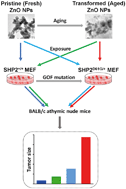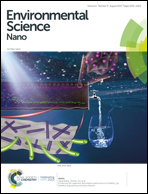Long-term exposure to low doses of fresh and aged zinc oxide nanoparticles causes cell malignant progression enhanced by a tyrosine phosphatase SHP2 gain-of-function mutation†
Abstract
Since most of the toxicity studies on zinc oxide nanoparticles (ZnO NPs) were concentrated on the pristine state, ignoring their transformation counterparts, firstly, the aim of the present study was to fill the knowledge gap of long-term effects of both pristine (fresh) and transformed (aged) ZnO NPs at sub-toxic doses. Secondly, considering that cancer is mainly caused by both genetic and environmental factors, we tried to investigate the carcinogenic potential of ZnO NPs with consideration of genetic background at the same time. Here, we evaluated the cytotoxicity, genotoxicity, and carcinogenic effects of fresh and aged ZnO NPs under long-term treatments (16 and 24 weeks), using two sub-toxic doses (0.75 and 1.5 μg mL−1) according to acute 72 h exposure. To determine the role of genetic background, wild-type mouse embryonic fibroblast (MEF SHP2+/+) cells and isogenic cytoplasmic protein tyrosine phosphatase (SHP2) point mutation (MEF SHP2D61G/+) cells were used. We found that compared to fresh NPs, aged ZnO NPs induced higher levels of ROS and double strand breaks in both kinds of cells. Meanwhile, MEF SHP2D61G/+ cells are more sensitive to ZnO NP-induced acute toxicity and DNA damage. On the other hand, long-term exposure of MEF cells to sub-toxic doses of aged ZnO NPs was able to induce more pronounced cell malignant progression, as indicated by the significant increases in the anchorage-independent cell growth ability, migration, and invasion, all cancer-like phenotypic hallmarks both in vitro and in vivo. Interestingly, such changes were significantly dependent on the cells we used, where the MEF SHP2D61G/+ background is particularly sensitive. Moreover, the ERK pathway was involved in the cell malignant progression induced by fresh and aged ZnO NPs. Altogether, our data suggest the potential carcinogenic risk of ZnO NPs and point out the interplay between environmental (ZnO NPs) and genetic factors (SHP2D61G/+ genetic background) on nanoparticle-associated carcinogenic effects.



 Please wait while we load your content...
Please wait while we load your content...